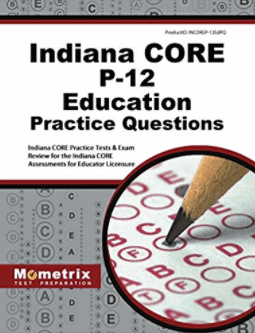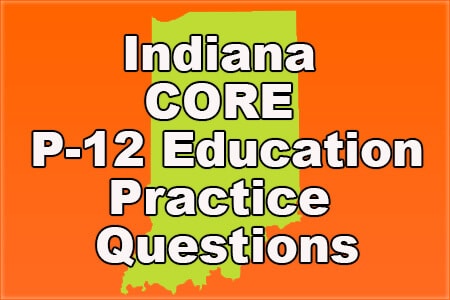If you are wanting to become a teacher in the state of Indiana the first thing you need to do, after college, of course, is to take the Indiana CORE Assessment for Educator Licensure. There are several tests that you can take underneath the Indiana CORE depending on which are you want to go into such as Elementary Education and Career and Technical Education.
The Indiana CORE Assessment helps the Department of Education to meet their goals of ensuring that candidates have the developmental and content area knowledge and skills that will be needed to effectively teach in Indiana public schools.
The Indiana CORE Assessment is aligned with state and national standards for educator preparation and also with state standards for the P-12 curriculum in Indiana.

The Indiana CORE P-12 Education exam is one of the testing options for those who wish to become a teacher in Indiana. The Indiana CORE P-12 Education exam is a computer-based exam that contains 100 multiple choice questions. The exam is timed for 105 minutes which does not include the 15 minute CBT tutorial.
The Indiana CORE P-12 Education exam contains 5 domain areas:
- Student Development and Diversity
- Learning Processes and Environments
- Instruction and Assessment
- Reading Instruction
- The Professional Environment

Indiana CORE P-12 Education Practice Test Questions
1.Of the following, which did John Dewey believe education should ideally be?
a. (b) and (d)
b.Child-centered
c. Teacher-centered
d. Curriculum-centered
2. Which of the following does Lev Vygotsky’s Zone of Proximal Development represent?
a. The distance between a learner’s being in one cognitive developmental stage or the next
b. The distance between the learner’s ability and the ability of a More Knowledgeable Other
c. The distance between learner externalized, audible and internalized, mental inner speech
d. The distance between a learner’s actual development and learner potential development
3. When sixth-graders fail to complete assignments or act out in class, to which of the following are teachers with experience and developmental perspectives more likely to attribute such events accurately, whereas teachers without these assets are more likely to choose one of the others?
a. ADHD
b. Mental illnesses
c. Behavioral problems
d. Adjustment problems
Answers
A: Dewey believed education should NOT be teacher-centered (c) or authoritarian; and also should not be exclusively child-centered (b) or curriculum-centered (d), but rather should include a balance of these latter two.
D: What Vygotsky termed the Zone of Proximal Development (ZPD) referred to his concept of the distance between the learner’s actual development, i.e., what s/he can do independently, and the learner’s potential development, i.e., what s/he can do with help/guidance from a More Knowledgeable Other (MKO). Vygotsky’s term does NOT refer to distance between the learner’s ability and the MKO’s ability (b). It does NOT refer to distance between cognitive developmental stages (a); in fact, he disagreed with Piaget’s belief that such stages were always the same in nature and sequence because Vygotsky believed these were highly influenced by cultural factors. Given his belief in variance in cognitive development, Vygotsky would not propose a distance between stages. Although Vygotsky did originate the concept and term of inner speech and its progressing from externalized and audible to internalized and mental (c), the ZPD does not refer to inner speech.
D: Although Attention Deficit Hyperactivity Disorder or ADHD (a) certainly includes inattention, short attention span, and impulsive behavior; students with mental illnesses (b) certainly can have difficulty completing assignments and/or exhibit disruptive class behavior; and assignment noncompliance and acting out in class can certainly be symptoms of behavior problems (c), teachers with more experience and developmental perspectives are more likely than those without these assets to realize such behaviors can actually be signs of adjustment problems. Many students begin middle school in sixth grade. Because schools can vary widely and because of change itself, students can have difficulty making transitions to middle school. The same applies to transitions from middle to high school.

